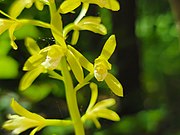Aplectrum
| Aplectrum | |
|---|---|

| |
| Aplectrum hyemale | |
| Scientific classification | |
| Kingdom: | Plantae |
| Clade: | Tracheophytes |
| Clade: | Angiosperms |
| Clade: | Monocots |
| Order: | Asparagales |
| Family: | Orchidaceae |
| Subfamily: | Epidendroideae |
| Tribe: | Epidendreae |
| Subtribe: | Calypsoinae |
| Genus: | Aplectrum (Nutt.) Torr. |
| Species: | A. hyemale
|
| Binomial name | |
| Aplectrum hyemale | |

| |
| State-level distribution of Aplectrum hyemale in the United States | |
| Synonyms[1] | |
|
List
| |
Aplectrum hyemale is a species of orchid native to the eastern United States and Canada, from Oklahoma east to the Carolinas and north to Minnesota, Ontario, Quebec and Massachusetts.[1] It is particularly common in the Appalachian Mountains, the Great Lakes Region, and the Ohio and Upper Mississippi Valleys. Isolated populations are also reported from Arizona.[2]
Aplectrum hyemale is the sole species of the genus Aplectrum. The generic name comes from Greek and signifies "spurless". The species is commonly referred to as Adam and Eve or putty root; the latter refers to the mucilaginous fluid which can be removed from the tubers when they are crushed, used by Native Americans to mend pottery.[3]
Aplectrum hyemale spreads underground through the growth of its tubers, forming large colonies. The leaves appear in late November and persist until March. They are uniquely pin-striped, with parallel alternating silvery-white and green stripes. In late May or early June the flower stalk emerges carrying several flowers, each only a few millimeters across.[4] It is sometimes confused with Tipularia discolor, another orchid species that occurs in eastern North America.[5][6]
There exists a color variation, Aplectrum hyemale var. pallidum which differs in flower color.[7]
Seeds and Germination
[edit]Aplectrum flowers are able to self-pollinate, thus are able to produce seeds asexually.[8] Aplectrum produces many dust like seeds and each contain minimal nutrient reserves.[9] Aplectrum seeds are a fraction of a millimeter in diameter[10] and are wind dispersed.[9] Aplectrum seeds are difficult to germination and propagate because they require a mycorrizal association.[11]
Pollination Biology
[edit]Little is known about the pollination of the Aplectrum. It flowers in the late spring[12] and the flowers lack nectar and does not attract many pollinators.[13] Reported floral visitors include the bees Bombus separatus and Bombus americanorum.[14] Since there are very few pollinators of Aplectrum, it relies on autogamy (selfing).[15]
Predation and Herbivory
[edit]There are two know predators of Aplectrum. White Tailed Deer (Odocoileus virginianus) which maybe related to decline of Aplectrum in some areas.[16] The second known potential predator is the Spur-Throated Grasshopper (Melanoplus acrophilus). This is the only known account of potential insect herbivory on Alpectrum.[17]
References
[edit]- ^ a b Kew World Checklist of Selected Plant Families
- ^ Biota of North America Program
- ^ Correll, D. S. (1950). Native orchids of North America north of Mexico. Stanford University Press, Stanford, CA.
- ^ Flora of North America v 26 p 632, Aplectrum hyemale (Muhlenburg ex Willdenow) Nuttall, Gen. N. Amer. Pl. 2: 198. 1818.
- ^ "Aplectrum hyemale (Putty Root), Similar Species". iNaturalist.org. Retrieved 18 December 2018.
- ^ Flora of North America v 26 p 624, Tipularia discolor (Pursh) Nuttall, Gen. N. Amer. Pl. 2: 195. 1818.
- ^ Richburg, Julie. "Aplectrum hyemale" (PDF). Native Plant Trust. New England Wild Flower Society. Retrieved 26 May 2021.
- ^ "Aplectrum hyemale". Botanical Gazette. 6 (8): 248. August 1881. doi:10.1086/325504. ISSN 0006-8071.
- ^ a b Whigham, Dennis F.; O’Neill, John P.; Rasmussen, Hanne N.; Caldwell, Bruce A.; McCormick, Melissa K. (2006-04-01). "Seed longevity in terrestrial orchids – Potential for persistent in situ seed banks". Biological Conservation. 129 (1): 24–30. doi:10.1016/j.biocon.2005.10.029. ISSN 0006-3207.
- ^ Stevens, W. C.; Dill, Florence E. (1942). "Aplectrum Spicatum in a Kansas Woodland". Transactions of the Kansas Academy of Science (1903-). 45: 138–151. doi:10.2307/3624993. ISSN 0022-8443.
- ^ Lauzer, Denis; Renaut, Sébastien; St-Arnaud, Marc; Barabé, Denis (2007). "In vitro Asymbiotic Germination, Protocorm Development, and Plantlet Acclimatization of Aplectrum hyemale (Muhl. Ex Willd.) Torr. (Orchidaceae)". The Journal of the Torrey Botanical Society. 134 (3): 344–348. ISSN 1095-5674.
- ^ "Aplectrum hyemale in Flora of North America @ efloras.org". www.efloras.org. Retrieved 2025-02-12.
- ^ Haines, Arthur (2011-11-08). New England Wild Flower Society's Flora Novae Angliae: A Manual for the Identification of Native and Naturalized Higher Vascular Plants of New England. Yale University Press. doi:10.12987/9780300184754. ISBN 978-0-300-18475-4.
- ^ Auclair, Allan N. (1972). "Comparative Ecology of the Orchids Aplectrum hyemale and Orchis spectabilis". Bulletin of the Torrey Botanical Club. 99 (1): 1–10. doi:10.2307/2484233. ISSN 0040-9618.
- ^ Haines, Arthur (2017-12-31). "New England Wild Flower Society's Flora Novae Angliae". doi:10.12987/9780300184754.
{{cite journal}}: Cite journal requires|journal=(help) - ^ "Puttyroot Guide - New York Natural Heritage Program". guides.nynhp.org. Retrieved 2025-02-12.
- ^ "Potential Herbivory on the Wintergreen Orchids Aplectrum hyemale and Tipularia discolor by the Spur-Throated Grasshopper Melanoplus acrophilus". Southeastern Naturalist. 16 (3). 2017-09-01. doi:10.1656/058.016.0317. ISSN 1528-7092.
External links
[edit] Media related to Aplectrum at Wikimedia Commons
Media related to Aplectrum at Wikimedia Commons- Plants For a Future
- Lady Bird Johnson Wildflower Center, University of Texas
- Go Botany, New England Wildflower Society
- North Carolina Native Plant Society
- Wisconsin State Department of Natural Resources
- North Carolina Wildflowers, Shrubs and Trees by Jeff Pippen





